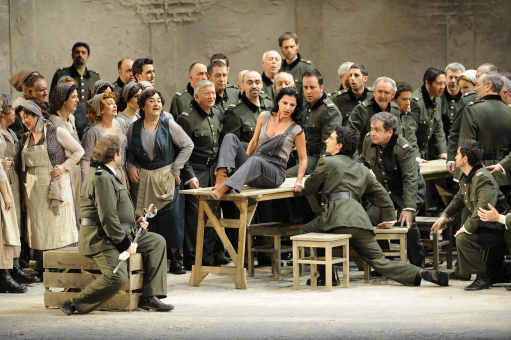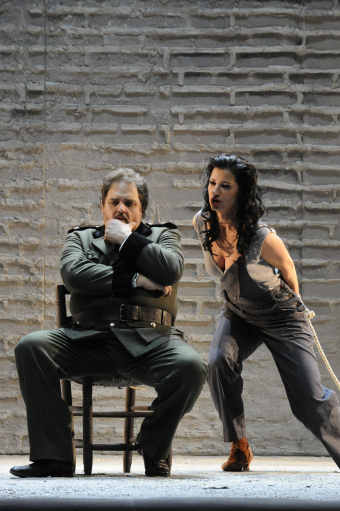Other Links
Editorial Board
-
Editor - Bill Kenny
-
Deputy Editor - Bob Briggs
Founder - Len Mullenger
Google Site Search
SEEN
AND HEARD INTERNATIONAL OPERA REVIEW
Bizet, Carmen :
Soloists, Bilbao Orkestra Sinfonikoa.
Coro de Ópera de Bilbao. Conductor: Patrick
Davin. Palacio Euskalduna de Bilbao. 14 & 15.
2.2009.
(JMI)
Production: Finnish National Opera.
But what can be done when during
rehearsals, Sonia Ganassi, one of
the best Carmens singing the role today, cancels?
The answer is clear: salvage the
performance as best as you can. Natascha Petrinsky stepped in and
saved the day with great dignity but
without much brightness. She is a good singer, very suited for other
roles of lesser importance, but Carmen is too big for her. At first
she was rather nervous, which gave problems with pitch, but her
acting was very good. The public at
premieres in Bilbao are well known for their coldness, but I think
they were basically right on this occasion. There was no applause
for the Habanera, Seguidilla or the Cards aria.
Director:
Arnaud Bernard
Sets: Alessandro Camera
Costumes: Carla Ricotti
Lighting: Patrick Méeüs
Choreography: Gianni Santucci
Casts:
Carmen: Natascha Petrinsky/Maria Riccarda Wesseling
Don
José: Marco Berti/Alejandro Roy.
Micaëla: Latonia Moore/Kristin Lewis
Escamillo: Teddy Tahu Rhodes/James Creswell
Zuñiga: Nicolas Testé
Morales: Javier Galán
Frasquita: Gladys Rossi
Mercedes: Nuria Lorenzo
Dancaïre: Manel Esteve
Remendado: Jon Plazaola

Carmen
seems to be a jinxed title for ABAO. In the last run (2003) the
heroine cancelled and had to be replaced at the eleventh hour
On this occasion both Carmen (Sonia Ganassi) and Don José
(Marcello Giordani) cancelled, with detrimental effects as a
result.
Arnaud Bernard is for me one of the most promising French stage
directors, and I have had the opportunity to attend several of his
works in Toulouse, where he has for some years been assistant to
Nicolas Joël. This time however, his work did not convince me
completely. The production comes from Finnish National Opera in
Helsinki, where it was premiered in the autumn of 2007, having also
visited Lausanne last May. The production moves the action to the
1950s, which does not make much difference to the work.
Mr Bernard’s production has some positive aspects: there is
outstanding direction of the crowd scenes, interesting and
attractive sets, good costumes (except for Micaëla in Act I) and a
remarkable set in Act III. Sadly,
there are also some less positive aspects to
, for example the almost constant use of a black curtain to
change scenes, which disturbs the flow of the drama.
The greatest change and perhaps
the least successful
aspect of Mr Bernard's interpretation
by comes in the last act which, instead of starting in the open
space near the bull ring, is set in the hotel room that Escamillo
shares with Carmen. Here, there is a balcony from which the
torero waves when the Choir sing “l’espada, Escamillo”.
Finally, Escamillo leaves and Carmen remains alone in the room.
Mr Bernard focused the act on the personal drama, eliminating the
traditional colourful stage chorus, which
became simply
an off-stage chorus. And
although it would certainly have made sense for the final
duet to take place in Escamillo’s room, instead
it took place in the street next to the ring.
Together with these positive and negatives
in the production, there are also some
errors of fact: La Guardia Civil in Spain, unlike the Army or
the Police, has been always a rural
organisation, even in the 1950s, but the action of Carmen
takes place in the city of Seville. Because of
this, the uniformed Guards singing
“La cloche a sonné, nous des ouvrières” seems
slightly absurd to a Spanish audience
and it would be refreshing if more attention
had been paid to the libretto
from this point of view.
If the cancellation of the leading singers was a huge
handicap for the performance, the presence of Patrick Davin in the
pit did not help much either. His reading
was too bland, superficial and routine to allow the opera to fly.
This was a huge disappointment. I have seen him in the past on
several occasions and I would never have expected so dull a reading
of Carmen from him. The Orchestra
also gave a very weak and lethargic performance. There were also
some problems of adjustment between stage and pit, particularly in
Act III and I had the impression that everything was under-rehearsed
musically, something which is not acceptable in a
well known opera house.

Don
José: Marco Berti and
Carmen: Natascha Petrinsky
In the second cast Carmen was played by Maria Riccarda Wesseling,
best known for her baroque interpretations. She has not got the
right voice for Carmen, something which became more apparent after a
decent first act.
Marco Berti is far from being an attractive Don José. His sallies
into the verista repertoire and the heavy Verdi roles have
made this singer into a tenor in whom
quantity predominates over quality. There is no question that he has
a shining and sonorous high register, but Don José requires a
sensitive singer as well as one with power.
He was not too good in the duet with Micaëla,
he sang the Flower aria with lots of decibels but without
much passion, while there was no feeling
of regret or remorse in the final scene.
On paper he made a very good substitute, but was ultimately
disappointing.
In the second cast the young Asturian tenor Alejandro Roy was very
promising. In one year he has made good
progress musically, with a middle range reminding me of Corelli,
although the high notes are more reminiscent of a somewhat
forced Carreras. In any case, his Don José was quite
convincing and I suspect that
hHis future will depend on his
intelligence and his capacity to say No.
Time will tell.
As
always, or almost always, the biggest success of the evening was for
Micaëla. Latonia Moore was the only
singer perfectly suited to the role, if we accept the figure she
cuts on stage. Her aria in the smugglers’ scene was the best thing
of the night.
Kristin Lewis was also good, not at the level of Latonia Moore the
day before, but still full of promise. She
is a soprano with an important voice in the middle range and she
knows how to sing, although there were some irregularities in the
higher zone. She seems ready for a
heavier repertoire and I am convinced that she has a
fine career ahead of her.
Teddy Tahu Rhodes was the reverse of
Latonia Moore, having the appearance of a
movie star but being vocally inadequate for the role of Escamillo.
The voice is decent in the middle, although he has problems with
projection. The high notes are too colourless
however and the bottom end of his singing
lacks consistency. James Creswell, nn
the next day made a better Toreador.
The voice is good, although his projection is not perfect,
but he reaches both ends of
the tessitura very adequately.
The secondary roles were very well served
in general. Javier Galan (Morales) and Nicholas Testé (Zuñiga)
were good. The male smugglers, Manel Esteve (Dancaïre) and Jon
Plazaola (Remendado), were even better and
Gladys Rossi and Nuria Lorenzo completed the cast without
difficulties.
At the premiere there was no more than courtesy shown to the
singers, except for Latonia Moore, and the creative team was
received almost in silence. For the second cast the audience was
much warmer, and Kristin Lewis and Alejandro Roy were
bothe received with cheers.
José M Irurzun
Pictures © E. Moreno Esquibel
Back
to Top
Cumulative Index Page
